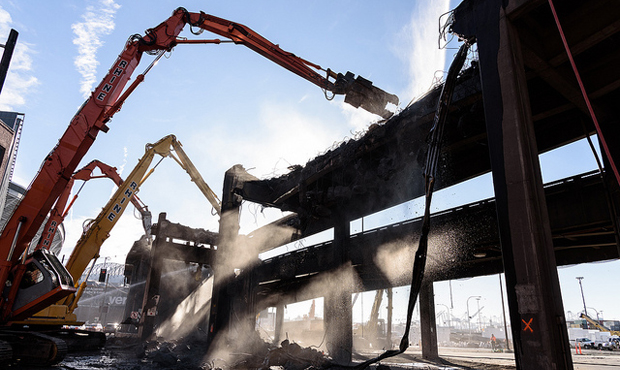VIADOOM: THE 2019 VIADUCT CLOSURE
By land, by rail, or by sea: How to beat Seattle’s Viadoom
Jan 11, 2019, 7:24 AM | Updated: Jan 13, 2019, 8:54 am
Whether you call it the Seattle Squeeze or Viadoom, or “Please God make it stop now,” the closure of Seattle’s Alaskan Way Viaduct will cause traffic to snarl. More than 90,000 daily car commuters are forced to find alternatives to the heavily-used route.
The viaduct closed Friday night. There is no express route through downtown Seattle for about three weeks until the replacement tunnel finally opens. In short, if you have to take a road in or out of Seattle — carpool, take a bus, use rideshare. Get as many people going the same direction into fewer vehicles.
RELATED: Mayor Durkan’s advice during the viaduct closure
RELATED: Employers preparing for viaduct closure
RELATED: Best way to get into downtown Seattle during Viadoom
If you can avoid driving, there are a few other options out there.
Rideshare / Carshare
The strain on traffic is an opportunity for the region’s rideshare and carshare companies who are vying for your business. Many have made plans specifically for the closure.
ReachNow is offering deals with the code “squeeze01” to attract new customers. It’s also expanded pick up areas to include neighborhoods near transit hubs. Also, if you start or finish your ride at a transit hub, you’ll get a $3 credit.
Uber is also offering a $2.75 discount to customers who start or finish rides at transit stations through Feb. 15. Lyft is doing the same — a $2.75 discount — for its customers coming and going from transit hubs.
Rideshare companies such as Lyft and Uber also offer an option to share your ride with other customers — like sharing a cab. If your routes are similar, you can share the car and cut down on the rate. This is an ideal option during Viadoom, putting multiple commuters into one vehicle, taking cars off the road.
Buses / Metro
King County Metro will have 20 standby buses to throw into the system during the closure. Check Metro’s schedules and maps for buses near your route.
Metro will have 12 buses that will reroute around the closure. They will make similar stops, but travel will take much longer.
Metro points to five park and rides outside Seattle which have parking capacity and have access to Seattle-bound buses.
- Burien Transit Center – Routes 120, 121, 122, 123 & 131
- Redondo Heights – Route 190
- Star Lake Park & Ride – Routes 190 & 192
- Burien Church of God – Route 131 (at Burien Transit Center)
- Normandy Park Congregational Church – Route 131 (at the Burien Transit Center)
There are also private parking lots near many transit hubs.
Metro also operates a program for vanpools, many of which are offering free rides during the closure. It also operates vanshares, which is a first/last mile option between transit centers.
Light rail / Sounder Train
The Sounder Train is one of the better options to get to downtown from north or south of the city. It runs from Everett to Seattle (stopping in Mukilteo and Edmonds), and from Lakewood to the south (stopping in SeaTac, Tukwila, Rainier Valley, and SoDo). There are four trips into Seattle in both the morning and the evening.
Check the Everett-Seattle schedule here. Check the Lakewood-Seattle schedule here.
Sound Transit has gap train it can activate to handle more passengers if needed.
Light rail is another option. Sound Transit’s Link light rail only extends as far north as the University of Washington, so it’s not as much help of you’re coming from that direction.
But Link also runs from from Angle Lake to the south of Seattle. Check the schedule from the south here.
Take a rideshare to and from the stations. That way, you don’t have to worry about parking. According to KIRO Radio Traffic Reporter Chris Sullivan, if you must drive to a station, get there early — very early. Many parking lots fill up quick.
Check out more of Sullivan’s tips here.
Water taxi
King County runs a water taxi between downtown and Seacrest Park in West Seattle (departing every 20 minutes), or from Vashon Island. It will add a second vessel during the viaduct closure. This option bypasses the West Seattle Bridge which is expected to be among the worst chokepoints during the closure.
These are walk-on ferries. They’re $5 each way. Check the water taxi schedule here.
The Washington State Ferry system is expected to run a regular schedule.
Don’t leave your home / alter commute time
WSDOT is recommending that if your schedule is flexible, flex it. Typical peak travel times are between 6-10 a.m. and 3-7 p.m. If there is any way to avoid those times, do it. Working Washington has recommended employers make schedules two weeks in advance and to not rely on on-call shifts.
Another suggestion put forth by Seattle leaders is for employees to stay home. Work from home using email or chatting services such as Google Hangouts to communicate. You can also use your smartphone to call coworkers for other business (because, fun fact, people once used phones to talk on, rather than text — and it still works).
Uber has offered work-from-home options to many of its 400 Seattle employees in downtown.
Bikeshare and biking
Just kidding.
Bikeshares actually are great for getting you from your home to a bus stop or light rail station. Maybe even getting around the city in general, especially if you’re an avid cyclist with calves of steel.
But these bikes aren’t getting you from Issaquah to Seattle in a timely commute. And also, it’s raining a whole lot these days. But count on these brightly colored bikes to get to and from transit hubs. If you can find an electric bike, take that. They make the trip super easy.
There are currently two bikeshares operating in Seattle (with a third on the way): Lime and Jump.
REALIGN99 CLOSURE TRAVEL TIP: Bike!
Build your workout right into your commute. Haven’t tried bike commuting before? Check out the @SeattleDOT bike map so you’re ready to hit the road during #Realign99: https://t.co/J8ly6LR0yU #SeattleSqueeze pic.twitter.com/7mphqgimpJ
— SR 99 (@BerthaDigsSR99) January 9, 2019
Resources
There are a few places online where car commuters can check for travel times, road conditions, and more. The first stop being MyNorthwest’s traffic map showing road conditions and traffic cameras. Also, MyNorthwest’s Chokepoints page for transportation news.
The Seattle Department of Transportation has also started a new website displaying travel times on key routes.
Helpful links
Chokepoints: Transportation news
Seattle traffic map: for monitoring travel times













